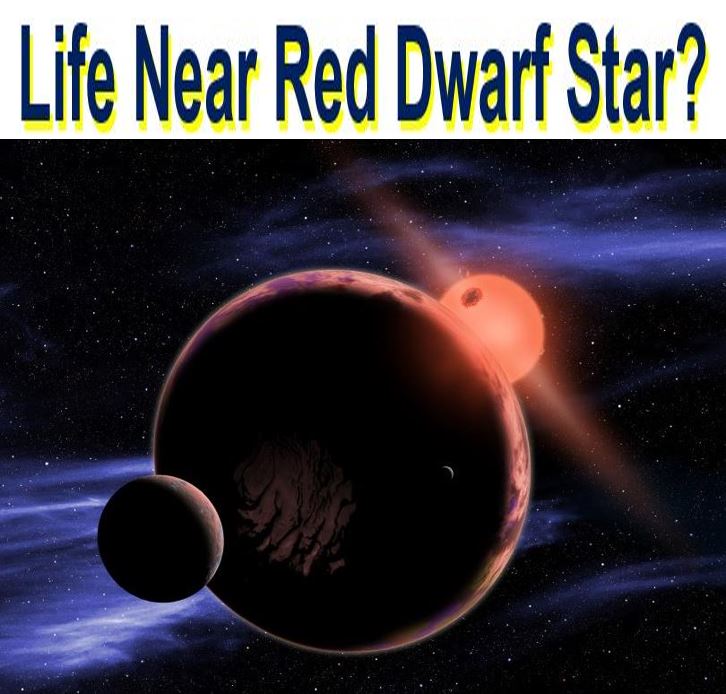Alien life might well be orbiting red dwarf stars say SETI scientists, who announced that their vast search of our Universe for extraterrestrial life forms will now include checking for signals from the planetary systems of approximately 20,000 red dwarf stars.
Red dwarf stars are smaller than our Sun and much cooler. They also burn for considerably longer than Sun-like stars.
According to the freedictionary.com, a red dwarf star is: “A star that is cool, small, and very faint. Red dwarfs burn very slowly and live for about 100 billion years. Although they are difficult to see, they are likely the most abundant type of star.”

The main objective of the SETI Institute, which is based at Mountain View in California, is to search for and hopefully one day find intelligent life in the Universe that does not come from Earth, i.e. an advanced alien civilization. SETI stands for Search for ExtraTerrestrial Intelligence.
According to SETI, over the next two years it plans to carefully gather and examine data from the vicinities of more than 20,000 red dwarf stars.
Scientists ignored red dwarf stars
Regarding astronomers’ attitude to red dwarf stars, Jon Richards, a Senior Software Engineer at SETI, said:
“Red dwarfs – the dim bulbs of the cosmos – have received scant attention by SETI scientists in the past. That’s because researchers made the seemingly reasonable assumption that other intelligent species would be on planets orbiting stars similar to the Sun.”
This potentially erroneous assessment was further boosted by the argument that red dwarfs would hardly have any planets with the potential for life as we know it in their Habitable Zone, also known as the Goldilocks Zone, because that orbital region would be significantly narrower than for brighter Sun-like stars.
Astronomers and astrophysicists had also thought that any planet inside the habitable zone would be orbiting so near its parent star that it would most likely be tidally blocked, i.e. one side would be continually facing the star.
A tidally-locked planet, they assumed, would not be able to be a host for any kind of life as we know it, because its star-facing side would be far too hot, while its dark side would be prohibitively cold.
Red dwarf star planetary systems might have life
Recent studies, however, have suggested that if planets within red dwarf star systems had oceans and atmospheres, heat would be transported from one hemisphere to the other, and a considerable fraction of the planet could be habitable.
Recent exoplanet data has suggested that between one-sixth and one-half of all the red dwarf stars out there have planets inside their habitable zones. NASA estimates that 6% of red dwarf stars have an Earth-sized planet in their habitable zone.
SETI’s Chief Astronomer, Dr. Seth Shostak, said:
“Significantly, three-fourths of all stars are red dwarfs. That means that if you observe a finite set of them – say the nearest twenty thousand – then on average they will be at only half the distance of the nearest twenty thousand Sun-like stars.”
Maybe older is better
Red dwarf stars last much longer than Sun-like stars, which means the planets that orbit them have been doing so for considerably longer.
According to scientists, every single red dwarf star that was born since the Big Bang, is still out there. On average, they are several billions of years older than Sun-like stars.
It takes a very long time for life as we know it to start, and significantly longer for it to evolve and produce an intelligent life form. Therefore, ultra-advanced extraterrestrials are more likely to exist in planetary systems that have been around for longer.
Regarding the age of planetary systems, Dr. Shostak said:
“This may be one instance in which older is better. Older solar systems have had more time to produce intelligent species.”
The SETI Institute will carry out the search on its Allen Telescope Array, located at the Hat Creek Radio Observatory, northeast of San Francisco, California. The array has a grouping of 42 antennas that can observe three stars at once.
Dr. Gerry Harp, Director at the Center for SETI Research, said:
“We’ll scrutinize targeted systems over several frequency bands between 1 and 10 GHz. Roughly half of those bands will be at so-called ‘magic frequencies’ – places on the radio dial that are directly related to basic mathematical constants.”
“It’s reasonable to speculate that extraterrestrials trying to attract attention might generate signals at such special frequencies.”
SETI estimates that its red-dwarf survey will take twenty-four months to complete. Targets are being chosen from a list containing about 70,000 red dwarf stars, compiled by Boston University’s Andrew West. The search will also include data from NASA’s Transiting Exoplanet Survey Satellite (TESS) project, which will study and examine nearby stars, including red dwarfs, for exoplanets (planets outside our Solar System).
Video – SETI talks
If you want to learn more about the Universe, watch this video.
